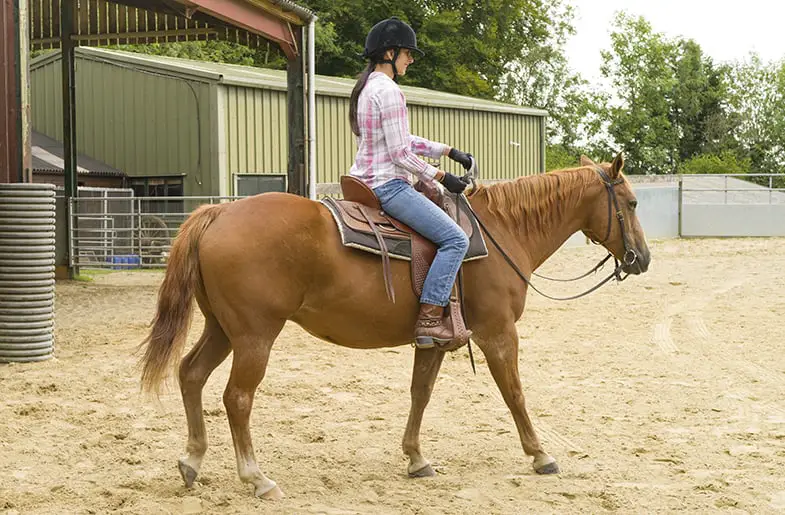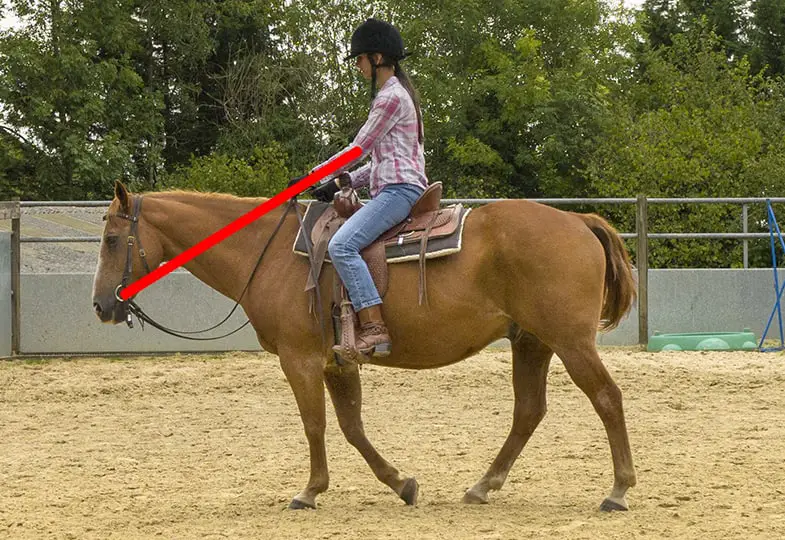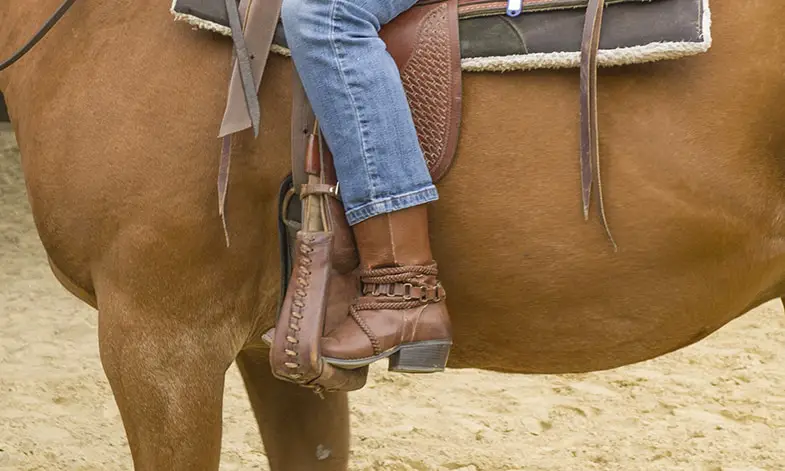As a riding instructor, I’ve spent many decades teaching hundreds (if not thousands) of people of all ages to ride and while some people are more eager than others I always start them out in the same way. Of course, being able to mount (and dismount) and stop the horse are the first things to learn but after that, it’s time to learn how to ride a horse at a walk.
Contrary to popular belief you can’t actually just sit there and let the horse do all of the work, no matter how well-trained the horse is, unfortunately, there’s a bit more to it than that. The good news though is that once you’ve mastered how to ride a horse at a walk, trotting, cantering, and even galloping will be much easier to learn.
How do you ask a horse to walk?
While most horses have been trained to understand verbal commands (referred to as cues) you need to ask them to walk with more than just your voice. You’ll need to use your hands, legs, seat as well as your voice to get them to move, but don’t worry if that sounds complicated it’s a lot more straightforward than it seems.
Reins
To start with you need to gather the reins so that there’s a light contact between you (more specifically your hands) and the bit. Make sure you don’t grab them too tightly though, otherwise the horse will be confused and will be less likely to move forward.
Legs
Once you have the correct grip on the reins you’ll need to let the horse know you want him to move forward by squeezing him with your lower legs. To do this keep your upper legs still and use your calves to lightly squeeze the horse just behind the girth or cinch area. If the horse doesn’t move then you can nudge him with your lower legs, but don’t kick him.
Seat
Shifting your body weight forward slightly will also signal to the horse that you want him to move. You don’t need to actually move in the saddle but instead just imagine you’re sitting in a chair and are about to get up; move your weight but not your body.
Voice
Depending on how the horse has been trained they may also understand verbal cues such as ‘walk’ or ‘walk on’, or a clicking of the tongue.
As soon as the horse starts to move forward you should relax your body and stop squeezing with your legs, otherwise, the horse will think you want him to go faster so will pick up speed. If the horse starts to slow you can use your leg and voice cues again so that he keeps on moving forward and doesn’t stop.
What’s the correct position for riding a horse at a walk?
Once the horse has started to move it’s important to maintain the correct position which should be:
Head
It can be difficult to not look down, especially when you first start learning to ride, but doing this will cause your back to stiffen up and unbalance your seat. Instead, keep your head up and look between the horse’s ears. Doing this will not only help you to relax more but will also help you to guide the horse. If you look where you’re going the horse will know where to go as your body will subconsciously tell them.
Shoulders
Your shoulders should be relaxed and even, if you can put them back that’s better but it’s more important that they remain relaxed and even. If they are uneven then you’ll end up sitting to one side which will unnerve the horse as they’ll think you’re about to fall. Tensing your shoulders will also make it harder for the horse to understand your commands, therefore making it more difficult for you to control the horse.
Arms
Your elbows should be slightly bent at the elbows but also relaxed, there should be a straight line between your elbows, hands, and the bit. That doesn’t mean that the reins should form part of the straight line though, they should remain loose. If you’re riding western style then you’ll have the reins much looser, especially if the horse has a curb bit.
Not sure what style of riding is best? Differences between Western and English riding.
Hands
I know you’ll probably be nervous but try not to grip the reins too tightly, they won’t give you any support but gripping onto them will confuse the horse and make him less responsive to your commands. Instead, keep a light contact and move your hands in time with the horse as he moves. As the horse moves his head may bob up and down and you should move your hands in time to this.
Back
You should keep your back upright but not stiff, it should be relaxed and free to move as the horse moves. It’s also important to keep your back centered and not sloping to one side, doing this will unbalance the horse.
Seat
Make sure you’re sitting comfortably and squarely in the saddle. Keep your position even and make sure you’re sitting on your seat bone and try not to lift yourself out of the saddle.
Legs
Unless you’re asking the horse to move try and keep your legs still, often referred to as ‘keeping them quiet’. Don’t let your legs move fords or swing about as you walk and keep your thighs, knees, and feet inwards, don’t let them turn outwards as it weakens your seat and cues. If you’re not sure if your legs are in the correct position look down toward your toes, if you can’t see them your legs are in the right place.
Feet
The ball of your foot should be in the stirrups and resting on the tread, your heels should be down slightly with your toes pointing upwards.
I know it might seem like there’s a lot to take in when it comes to keeping the correct position but, while it’ll be difficult to start with, in time it’ll be second nature and you won’t even think about it. It’s also worth pointing out that, unlike other paces, the walk has no moment of suspension which means that the horse always has at least two feet on the ground. This means that you won’t bounce around so can concentrate on improving your balance rather than staying in the saddle.
How do you move with the horse at a walk?
As the horse starts to move try and feel the rocking movement of his hips. As his hind foot leaves the ground you’ll feel him move up and forward slightly, likewise, you’ll feel his hip drop and move back as he puts his foot back down. Rather than trying to sit as still as possible try and rock with this movement, don’t move your seat though as this will unbalance him, instead relax and you’ll automatically move with the horse. The best way of doing this is by relaxing and going with the flow; the more tense you are the harder it’ll be for you to feel the horse and the more tired and sore you’ll become.
Some instructors will tell you to let go of the reins (while they lead the horse or put them on a lunge), put your arms out to the side, and close your eyes. The theory is that you’ll be able to feel the horse and move with it, therefore helping your balance but I don’t always like to do this. While I appreciate its benefits I think that if you’re nervous already making you close your eyes and let go of the horse will only make you feel worse.
Want to know more about how horses move? How to recognize and understand horse gaits.
How do you improve your position when riding a horse at a walk?
Horseback riding uses muscles that we don’t use in our normal daily life which means that it will feel odd to start with and you’ll probably ache after too. As they say, practice makes perfect and this is very true for riding a horse at any pace, especially a walk.
As well as practicing there are a number of exercises that you can do to improve and strengthen your core muscles. You can read more about those in this article: core exercises equestrians swear by.
Not sure what the best age to learn is? When’s the best time to learn to ride?
Want a quick recap? Learn how to stop a horse.
What next? Now that you’ve learned to walk it’s time to learn how to ride a horse at a trot.
I hope you found this article helpful. If you did I’d be grateful if you could share it please as it would really help me.
Recommended products
Over the years I have tried hundreds of different horsey products, from various blankets and halters to different treats. Some I’ve loved, others I’ve hated but I thought I’d share with you my top all-time favorite products, the ones I never leave the yard without. I’ve included links to the products (which are in no particular order) that I really think are great.
- Horse Knots by Reference Ready – If you’re like me and enjoy pocket reference guides then you’ll love this knot tying guide. These handy cards can easily fit in your pocket or attach to the saddle for quick reference. They’re waterproof, durable and are color coded to make them easy to follow.
- Mane ’n Tail Detangler – Even if you never show your horse you’ll need to detangle his tail from time to time (and possibly his mane too) which is always a challenging chore! I’ve found that if I run a little bit of detangler through my horse’s tails every few days it stops them from getting matted up and makes combing them easy, even if they’re coated in mud. I don’t know if I should admit to this or not but it also works wonders on my hair.
- TAKEKIT Pro clippers – Over the years I’ve tried a lot of different clippers and while some were obviously better than others I found these to be by far the best. They are heavier than a lot of other clippers but for me, that’s a good thing, it makes them feel more sturdy and hardwearing. On top of that they have a range of speeds so are just as good for clipping your horse’s back as they are his face. I also like the fact that they come in a handy carry case but that’s not for everybody. The company that makes them is super good and incredibly helpful too, a real bonus these days. The only thing I wasn’t keen on was the fact that it doesn’t come with any oil, but that’s not a major problem as it’s not difficult to buy lubricant.
- Shire’s ball feeder – There are so many boredom buster toys out there but I like to use these every day, regardless of whether or not my horses are bored. I find that it helps to encourage my horses to problem solve by rewarding them with treats (or pieces of fruit) but it also mimics their natural grazing behavior which helps to keep them calm and de-stressed.
- Horse safe mirror – This is a strange one that many people are surprised about but I like to put horse safe mirrors in the trailers as well as in the quarantine stalls. It helps to prevent the feeling of isolation by giving the impression of other horses being around. Being herd animals horses can get extremely stressed when they feel that they’re on their own but with these stick-on mirrors, they believe that at least one other horse is with them.
- Rectal thermometer – I know this isn’t glamourous at all but it’s vital for your horse’s well-being to be able to check their temperature and a rectal thermometer is the easiest way of doing this which is why I’ve added it to the list.
Shopping lists
I’ve also put together a few shopping lists of essential items that I’ve found helpful over the years. I’ve broken the lists down into different categories rather than put everything in one massive list 😉




